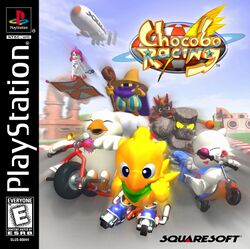The wiki is lacking in content. You can help by creating a new article. See the to do list for more ways you can help.
New user registration has been restored. Thank you for your patience.
Welcome Indie Wiki Jammers! Check out here for info on the jam
Chocobo Racing
Chocobo Racing is a racing game of the Chocobo series that was released for the PlayStation in 1999. The game was both developed and published by Square.
As a formulaic kart racer, Chocobo Racing is often compared to the Mario Kart series. Its gameplay is mostly comparable to Mario Kart 64, which was the latest Mario Kart installment at the time. The game stars Chocobo, the titular character of the franchise. Most of the game's soundtrack reuses tracks from earlier Final Fantasy titles.
Chocobo Racing was later re-released for Japan's Chocobo Collection compilation, alongside Chocobo Stallion and Dice de Chocobo. On December 20, 2001, Chocobo Racing was re-released individually as part of the PSone Books series.
Story[edit]
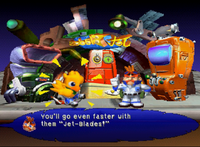
The story is nine chapters long and is presented in a pop-up book fashion with accompanying full-motion video. To progress through the Story mode, the racer only needs to win against a racer in each chapter. A cutscene of the story plays before each chapter, although the player has the option to skip them to directly begin the race.
The story opens with chapter one, "Gadgets a go-go," where Cid presents Chocobo with a pair of Jet-Blades and offers him to take a test-run with them on the racetrack behind his lab. After the race, Mog shows up and asks Cid about the progress of the racing machine he commissioned. Cid promises to bring the machine by tomorrow, but later confides to Chocobo that he forgo it. The next day, Cid provides Mog his scooter, and Chocobo and Mog get into a race. After Chocobo wins, Mog confronts Cid over his vehicle's poor performance, but Cid replies that Chocobo won because of the differences in their abilities. He explains that the secret of Chocobo's Dash ability is the Blue Crystal on his leg-ring. Mog mulls over his Flap ability and decides he wants a Blue Crystal as well, so Cid recommends that the two go on an adventure to discover the secret of the Blue Crystal.
The two head out to discover the secret behind the Blue Crystal, meeting and racing other characters along the way. When the group reaches Mysidia, a White Mage there notices that all the companions have Magicite, which the other characters had previously referred to as Blue Crystals. The companions want to know the legend behind the Magicite Shards, but the White Mage agrees to tell them on the condition that they win against her in a race on the Floating Gardens. After the race, the White Mage reveals that the Magicite Shards used to be one large Magicite Crystal, but since others constantly fought over it, Ming-Wu broke the Crystal into eight pieces and scattered the shards to the four winds. The Magicite Crystal would be restored once all eight pieces are brought together. After this discovery, the companions continue searching for other racers that have a Magicite Shard.
After beating Behemoth in a race, he joins the companions as their eighth member. Once this happens, the group notices that their Magicite shards are starting to glow, and Mog discovers that he possessed Magicite all along. The convergence of all eight shards of the Magicite crystal fulfills Ming-Wu's prophecy, and the gate to Fantasia opens.
When the companions arrive in Fantasia, they are greeted by the Esper king, Bahamut. He decides to test their worth with a final trial, and welcomes their attempts to defeat him in a race. After the race, Bahamut acknowledges the powers of the group. He goes on to rhetorically ask if the companions knew why Ming-Wu broke up the Magicite. Bahamut is pleased that the companions came together in goodwill, and he decides to leave the portal between the world and Fantasia open, declaring that the two worlds will from now on live in harmony.
Gameplay[edit]
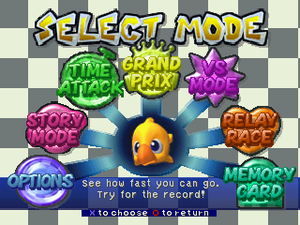
In Chocobo Racing, most of the characters ride in go-karts. Other characters fly, drive scooters, ride magic carpets, or even run on their own. There are five different racing modes:
- Story Mode: Players are guided through the story of Chocobo Racing, which is narrated by Cid, in the form of an onscreen version of a pop-up book. Players who complete the Story Mode are given the chance to create their own racer; completing the Story Mode also unlocks racers.
- Versus Mode: Two players can race each other on a horizontally split screen, where one player races viewing the top half of the screen and the other player races viewing the bottom half.
- GP Mode: The Grand Prix mode, the player races computer-controlled opponents in four selected tracks of their choice.
- Relay Race Mode: The player chooses three racers to compete in a relay match.
- Time Attack Mode: The player can select any stage and try to beat the fastest time record set there.
Upon completion of the Story Mode, players are assigned a number of points determined by their performance, with 100 being the highest number. Using those points, the player is given the option of creating a racer with customized color and performance. The point value is distributed among five parameters: Max Speed, Acceleration, Grip, Drift, and A.G.S., which determines how fast the racer's ability gauge charges. A maximum of twenty points can be assigned to each of the five racing parameters. Customized racers can be used in all of the game's modes except for the Story Mode, and only the main characters and Bahamut can be customized.
Basic controls[edit]
While racing as any character, the player can accelerate, brake, reverse, activate Magic Stones, or use a "special ability" using the controller's analog stick and buttons. An additional move is the skid, which is executed by simultaneously braking and accelerating into a turn; as the game's cornering technique, the skid is useful for taking sharp turns quickly. If the player skids too sharply, however, the player's character will spin out. Before the start of any race, the player's character receives a speed boost if the player accelerates at the correct time during the countdown.
Magic Stones[edit]
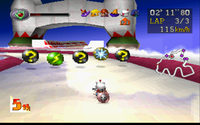
Magic Stones are scattered throughout each course. Racers can pick up Magic Stones by driving through them and stolen. There are eight types of Magic Stones, each with their own symbol and effect. Racers can steal Magic Stones from an opponent by bumping into them. Up to three Magic Stones can be carried at once, and having two or three of the same type further increases the Magic Stone's capabilities. Magic Stones with a question mark give a random type of Magic Stone.
| Name | Description |
|---|---|
| Haste | When activated, a Haste Stone casts the spell Haste, which gives the racer a brief burst of speed, similar to the Dash ability. Activating two and three allocated Haste Stones casts Haste2 and Haste3 respectively, both further increasing the duration of the speed boost. |
| Fire | When activated, a Fire Stone casts the spell Fire, which shoots a fireball in a straight line; if the fireball strikes a racer, they crash. Activating two allocated Fire Stones casts Fira, which shoots a homing fireball at the nearest racer. Activating three allocated Fire Stones casts Firaga, which shoots homing fireballs at all other racers. |
| Ice | When activated, an Ice Stone casts the spell Blizzard, in which the opponent drops a patch of ice on the ground. Activating two allocated Ice Stones casts Blizzara, in which six patches of ice are dropped onto the ground. Activating three allocated Ice Stones casts Blizzaga, which causes all opponents on the course to spin out and crash. |
| Thunder | When activated, a Thunder Stone casts the spell Thunder, in which a lightning bolt is blasted at an opponent. There is a 60% chance of it hitting the opponent. Activating two allocated Thunder Stones casts Thundara, which fires three lightning bolts at opponents with an 80% hit rate. Activating three allocated Thunder Stones casts Thundaga, which fires six lightning bolts at opponents with a 100% hit rate. |
| Minimize | When activated, a Minimize Stone casts the spell Mini, which diminishes all opponents to 75% of their original speed and size. Activating two allocated Mini Stones casts Mini2, in which all opponents are diminished to 50% of their original speed and size. Activating three allocated Mini Stones casts Mini3, diminishing all opponents to 25% of their original speed and size; this allows them to be run over and flattened. |
| Reflect | When activated, a Reflect Stone casts the spell Reflect, which reflects a spell cast by another racer and causes it to turn upon them. Unlike other Magic Stones, Reflect Stones do not increase in power when more than one is collected, but are instead stored behind the racer. |
| Doom | When activated, a Doom Stone casts the spell Curse on the nearest opponent. When cursed, an opponent crashes after ten seconds. If a cursed racer bumps into another racer, they can pass it to their opponent and avoid crashing. Like Reflect Stones, Doom Stones do not increase in power when more than one is collected, but are instead stored behind the racer. |
| Ultima | When activated, a Ultima Stone casts the spell Ultima, causing all opponents to spin uncontrollably. Activating two allocated Ultima Stones casts Ultima2, causing all opponents to crash. Activating three allocated Ultima Stones casts Ultima3, causing all opponents to crash catastrophically. |
Abilities[edit]
Before each race, the player is prompted to assign a ability to the selected character. During a race, the player can only activate the chosen ability when the meter in the upper left-hand corner of the screen is full. After using the ability, the player must wait for the meter to recharge to use it again. A list of special abilities and their respective effects are as follows:
| Name | Description |
|---|---|
| Dash | Speeds the player's character up for a short period of time. |
| Flap | Allows the player's character to fly over bad terrain for a short period of time. |
| Grip-Up | Using the ability gives better handling for the character's vehicle. |
| Mug | Steals an opponent's Magic Stone |
| Magic Plus | Automatically activates when the ability meter fills up, and it increases the power of the player's allocated Magic Stones (if the player has one Dash stone, for example, its power increases such that the player has two allocated Dash Stones when Magic Plus activates). |
| Barrier | Automatically activates when the ability meter fills up, and it protects the player's character from offensive magical attacks. The shield that Barrier provides lasts until the player's character is attacked. |
| Receive | The player receives Magic Stones used on their character. |
| Charge | Enables the player's character to accelerate with a short burst of speed and wreck opponents by ramming into them. |
| Megaflare | Rains fireballs upon all of the player's opponents. |
| Gunblade | Speeds the player's character up until taking the lead. Each time the player's character passes opponents, a gunblade slashes out and causes them to crash. |
Courses[edit]
There are ten courses in the game. The first eight are available from the start, and the last two are unlockable.
| Name | Chapter | Length | Difficulty | Description |
|---|---|---|---|---|
| Cid's Test Track | Chapter 1: Gadgets a go-go! | 0.77 miles (1,239 meters) | 1/5 | A practice racetrack behind Cid's lab. This is the most basic course, without the hairpin turns and obstacles seen in the later tracks. |
| Moogle Forest | Chapter 2: Moogling Right Along! | 0.84 miles (1,352 meters) | 2/5 | A racetrack set up around a forest, with grassy embankments and a path winding through trees. In Story mode, Mog designed the track to challenge Chocobo on. In Story Mode, the course introduces the Haste Magic Stones. |
| The Ancient Gate | Chapter 3: A Life in Ruins! | 0.84 miles (1,352 meters) | 2/5 | A track located in the ruins of the village gate and overseen by Golem. In Story Mode, the course introduces the Fire Stones. |
| Mythril Mines | Chapter 4: The Pleasure is Mine! | 1.03 miles (1,658 meters) | 2/5 | A track based around an old, abandoned Mythril mining station. In Story Mode, this course introduces the Ice Stones, and Goblin is raced aginst. |
| The Black Manor | Chapter 5: Mind Your Manor! | 1.17 miles (1,883 meters) | 3/5 | A track set in a haunted manor deep in the Cursed Forest and home of the Black Magician. In Story mode, the course introduces the Thunder Stones. |
| Floating Gardens | Chapter 6: Crystal Clear! | 1.17 miles (1,883 meters) | 3/5 | An airborne track among hanging gardens, built by the ancestors of Mysidia. In Story Mode, the course introduces the Minimize Stones, and the opponent is White Mage. |
| Gingerbread Land | Chapter 7: Maybe it's something I ate | 1.55 miles (2,494 meters) | 4/5 | A racetrack decorated by various candies and sweets. In Story Mode, the course introduces the Reflect Stones, and the opponent is Chubby Chocobo. |
| Vulcan-O Valley | Chapter 8: Won't you be my lava! | 1.46 miles (2,350 meters) | 4/5 | A track amidst a desolate wasteland, with pits of lava and falling rocks, and home to Behemoth. In Story Mode, the course introduces the Doom Stones. |
| Fantasia | Chapter 9: Final Fantasia | 1.63 miles (2,623 meters) | 5/5 | The realm of the Espers and their king Bahamut. Fantasia is the longest and final course in Story Mode, and it introduces the Ultima Stones. After completing Story mode, this track is unlocked for other modes. |
| F.F.VIII Circuit | N/A | 1.46 miles (2,350 meters) | 5/5 | A long and winding course set on the streets of Deling City and styled after Squall's medallion Griever. The F.F.VIII Circuit is unlocked after completing Story Mode a second time. |
Characters[edit]
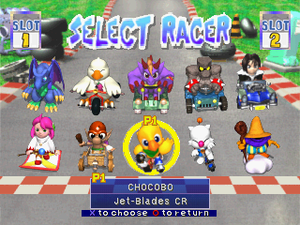
The main characters, which are integral to the Chocobo series, are accessible from the start. There are secret characters that can be unlocked by completing the Story Mode a successive number of times.
Main characters[edit]
| Name | Vehicle | Ability |
|---|---|---|
| Chocobo | Jet-Blades CR | Dash |
| Mog | Mog-Scooter R2 | Flap |
| Golem | Rockin Roller V8 | Grip-Up |
| Goblin | Gob-Cart H4 | Mug |
| Black Magician | MagiCloud MK-1 | Magic Plus |
| White Mage | Cosmic Carpet | Barrier |
| Chubby Chocobo | Phat-Burner Plus | Receive |
| Behemoth | Behemoth-Buggy 99 | Charge |
Unlockable characters[edit]
There are ten unlockable characters, most being from the main Final Fantasy series or another Square franchise. other Square franchises. All of them are unlocked by completing Story Mode a certain number of times. The S.S. Invincible is the fast racer in the game. Characters unlocked after Squall are hidden on the racer select screen, and can be selected by highlighting Squall and entering a certain button combination.
| Name | Vehicle | Ability | Unlocked by | Origin | Button combination |
|---|---|---|---|---|---|
| Bahamut | Dragon Wings | Megaflare | Completing the Story Mode one time | Final Fantasy series | N/A |
| Squall | The Tempest | Gunblade | Completing the Story Mode two times | Final Fantasy VIII | |
| Cid's Tank | N/A | N/A | Completing the Story Mode three times | Chocobo Racing | Pressing |
| Mumba | None | None | Completing the Story Mode four times | Final Fantasy VIII | Pressing |
| Cloud | Hardy-Daytona | None | Completing the Story Mode five times | Final Fantasy VII | Pressing |
| Cactaur | None | None | Completing the Story Mode six times | Final Fantasy series | Pressing |
| Aya | Police car | None | Completing the Story Mode seven times | Parasite Eve | Pressing |
| Classic Chocobo | None | None | Completing the Story Mode eight times | Final Fantasy II and Final Fantasy III (Famicom) | Pressing |
| SS Invincible | None | None | Completing the Story Mode nine times | Final Fantasy III | Pressing |
| Jack | None | None | Completing the Story Mode ten times | 3-D WorldRunner | Pressing |
Music[edit]
- Main article: Chocobo Racing Original Soundtrack
Nearly every song are remixes of tracks that Nobuo Uematsu originally composed for various Final Fantasy games, although Kenji Ito is credited as the game's composer. In March 1999, Chocobo Racing had a soundtrack release for the music used in the game.
- The music heard in the opening FMV is the Chocobo Theme played on a saxophone.
- "Cid's Test Track" is a variation of the Chocobo Theme heard in Final Fantasy Adventure.
- "Moogle Forest" was supposed to be the Town Theme in Final Fantasy VI, but never made it in the final game.
- "The Ancient Gate" is the Boss Battle Theme from Final Fantasy III.
- "Mythril Mines" is the Gurugu Volcano Theme from Final Fantasy.
- "The Black Manor" is the Mage Shrine Theme from Final Fantasy II.
- "Floating Gardens" is a variation of "A New Origin", the musical piece heard during the ending credits of Final Fantasy V.
- "Gingerbread Land" is another variation of the Chocobo Theme.
- "Vulcan-O Valley" is the Boss battle music from Final Fantasy II.
- "Fantasia" is the Dark Cloud Final Battle Theme from Final Fantasy III.
- "F.F.VIII Circuit" is the Battle Theme in Final Fantasy VIII.
- "Loser's Requiem" is an off-key variation of the Chocobo Theme.
- "Winner's Jig" is the Victory Theme heard in every Final Fantasy game.
- "Chocobo's Tune" is the familiar Chocobo Theme.
- "Mog's Muzik" is a musical piece called "Critter Tripper Fritter", heard in Final Fantasy V and Final Fantasy VI.
- "Cid's Sonata" is a musical piece called "Hey Cid", heard in Final Fantasy IV.
- "Goblin's Gambol" is the Faris Theme/Pirate's Hideout Theme from Final Fantasy V.
- "Road Rollick" is the musical piece "Good Fellows" from Final Fantasy III.
- "Mage's Melody" is the Town Theme from Final Fantasy.
- "Magician's March" is the Mysidia Theme from Final Fantasy IV.
- "Golem's Groove" is the Castle Theme from Final Fantasy II.
- "Chubby's Bop-pop" is the musical piece "Here Comes the Fat Chocobo" from Final Fantasy IV.
- "Behemoth's Theme" is one of the Cave/Dungeon Themes from Final Fantasy III.
- "The Esper King" starts out as the Intro from Final Fantasy VI, then turns into Sephiroth's Theme from Final Fantasy VII.
- "Spooky-Wooky!!!" is the Confronting Dark Cloud Theme from Final Fantasy III.
- "La-La-Legend" is the Data Select/Crystal Room Theme from every Final Fantasy game.
- "Chocobo Choosin'" is another Chocobo Theme variation.
- "Chocobo Creatin'" is the Chocobo Theme's bass line.
- "Happily Ever Chocobo" is another Chocobo Theme variation.
- "Diamonds in my Heart" is an original musical piece.
Development[edit]
The first demonstration of Chocobo Racing was at the Fall Tokyo Game Show '98; it was then unclear if there would be a North American release. In the release of Chocobo's Dungeon 2, a bonus CD included a video clip of the game.[1] Originally slated to be released in late September/October, the release date was moved to August 1999 because "It was done early, and is now ready to go".[2] There was a promotional event known as the Chocobo Racing Grand Prix Contest that ran from September 30, 1999 to December 8, 1999. The contest was sponsored by Square EA.
Reception[edit]
Chocobo Racing is sometimes accused of merely being as cash-in attempt for the kart racer genre originating from Mario Kart series. The resulting game was received as average among several reviewers, criticized as being of low quality, with unpolished graphics, crude track designs, and poor controls. The game scored a 4.4 in GameSpot's review and a mediocre 5.6 in IGN's review.
Reader reviews are considerably more receptive; Chocobo Racing scores a 7.2 among readers at GameSpot and a 7.1 average among IGN subscribers. The game was not successful commercially, as it only sold 300,000 units in Japan.[3]
External links[edit]
- Official North American website (archived)
- Official Japanese web page
 Chocobo Racing on MobyGames
Chocobo Racing on MobyGames Chocobo Racing on GameFAQs
Chocobo Racing on GameFAQs
References[edit]
- ^ Chocobo Brings Surprise Extras. IGN. Published December 11, 1998.
- ^ Chocobo Racing Moves On Up. IGN. Published May 27, 1999.
- ^ Creative Uncut - Square Game List
| This article uses content from Wikipedia (view authors), and falls under the compatible Creative Commons license. |
